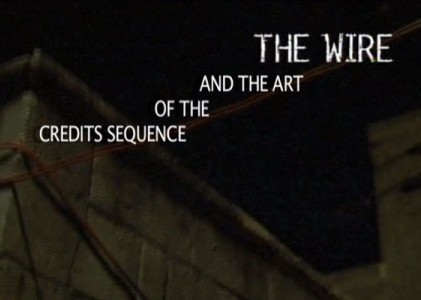Extra Credit, Part 4
Making The Wire, Museum of the Moving Image, July 30, 2008
This video essay is part of a series on The Wire. Also on Moving Image Source: Dana Polan on the show's Balzacian universe, Nelson George on its complex portrayal of black America, David Schwartz on its view of life as a chess game, and video essays on the Season 1, Season 2, Season 3, and Season 5 credits by Andrew Dignan, Kevin B. Lee, and Matt Zoller Seitz.
The following text is the voiceover script for the video essay on The Wire's Season 4 credits.
Season 4 of The Wire finds us within the public school system. Standardized testing has been forced into the curriculum at the expense of applied learning. There's a youthful exuberance to the credits, extending from the playful cutting style to the shot selection to the young performers selected to sing the latest rendition of the show's theme song. While ostensibly still a cop show, the emphasis law enforcement will play is lessened somewhat, as the goal here is exploring how criminals are created as opposed to how we incarcerate them. With no positive reinforcement in the home and no real employment opportunities within the community, the neighborhood kids see school as a layover on the road to working a corner.
The sequence pushes forward the idea that todays problem children are destined to become tomorrow's assignment. A wall-mounted convex mirror used to monitor children rounding a corner is placed alongside grainy surveillance footage. Even an image as innocuous as a small boy carrying a bookbag has been corrupted by the jittery effect of a camera's iris snapping open and shut.
There's a procession of shots near the end of the credits that encapsulates everything The Wire has been working to establish over the years. A local shopkeeper spins open a countertop security window, sending through a pack of smokes; a hand spins a pair of expensive-looking designer rims; a piece of playground equipment spins anonymous at night; a child rolls a large tire around in an empty alley; bundles of narcotics are packed around a spare tire in the back of a car with a piece of carpeting pulled up to conceal them. And then a similar cut of fabric, this time a body being carried from an abandoned row house.
The same motions are repeated throughout, and the eye is drawn to how these shots flow seamlessly into one another: The bodega is a front for drug distribution; the rims represent wealth and status among street youth; the playground equipment, an image of youthful innocence, is corrupted by the sight of an adult perched upon it, holding an alcoholic beverage; the child with the tire, left unsupervised, is forced to amuse himself with whatever is available; the drugs are another form of self-amusement; and of course there's the corpse, where all this is destined to lead. —A.D. ![]()
LATEST ARTICLES
-20140814-173707-thumb3.jpg)
Fighting Words
by Imogen Sara Smith
posted August 12, 2014

Fighting Words, Part 2
by Imogen Sara Smith
posted August 20, 2014

On the Margins: The Fil…
by Andrew Chan
posted August 12, 2014

Robin Williams: A Sense…
by David Schwartz
posted August 12, 2014
 The Wire's Season 4 credits
The Wire's Season 4 credits
RELATED ARTICLE
Extra Credit, Part 1 by Andrew Dignan, Kevin B. Lee and Matt Zoller SeitzExtra Credit, Part 2 by Andrew Dignan, Kevin B. Lee and Matt Zoller Seitz
Extra Credit, Part 3 by Andrew Dignan, Kevin B. Lee and Matt Zoller Seitz
Extra Credit, Part 5 by Andrew Dignan, Kevin B. Lee and Matt Zoller Seitz
Invisible City by Dana Polan
Across Racial Lines by Nelson George
Kings and Pawns by David Schwartz
More: Article Archive
THE AUTHORS
Andrew Dignan is a film producer and occasional blogger living in Los Angeles. His last film, the Sundance selection Steel City, is now on DVD and he is currently in pre-production on two features and a short scheduled to shoot this fall.
More articles by Andrew DignanKevin B. Lee is editor of the Keyframe journal at Fandor and programming executive at dGenerate Films.
More articles by Kevin B. LeeMatt Zoller Seitz is a writer and filmmaker whose debut feature, the romantic comedy Home, is available through Netflix and Amazon. His writing on film and television has appeared in The New York Times, New York Press, and The Star Ledger, among other places. He is also the founder of The House Next Door, a movie and TV criticism website.
More articles by Matt Zoller SeitzAuthor's Website: The House Next Door

